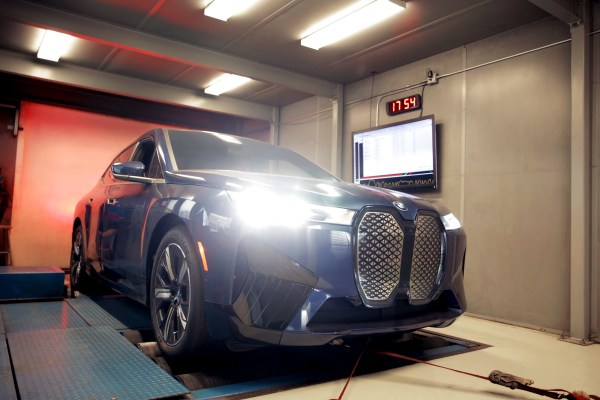Battery startup Our Next Energy (ONE) and BMW today said the carmaker’s prototype of its flagship EV, iX, will run on ONE’s unique Gemini dual-chemistry battery pack by the end of the year.
BMW’s iX was introduced late last year with a maximum range of 324 miles, based on estimates from the U.S. Environmental Protection Agency. With the prototype, ONE is hoping to nearly double that to 600 miles.
That’s an enormous leap above the iX’s range today, which sits just above what many automakers say is the 300-mile sweet spot for EV adoption. Such an increase may seem unnecessarily decadent — after all, how many road-trippers travel 600 miles, or eight hours at highway speeds, without taking a break? But for ONE founder and CEO Mujeeb Ijaz, it’s all about meeting drivers’ range expectations even in the most extreme conditions.
While EVs have made great strides in the last decade in meeting customer expectations, Ijaz feels they’re not nearly where they need to be once you factor in things like cold weather, trailer towing or driving at highway speeds. Towing with Ford’s new F-150 Lightning, for example, cuts range by about half, while many (though not all) EVs will travel about 10% to 20% less than their stated range when driven at a consistent 75 mph.
“I’m thoroughly convinced that to solve the market adoption, we’re going to need to double the amount of energy on board to deal with and overcome all the real-world conditions that are going to be thrown at EVs,” Ijaz said. “I’ve seen in 30 years how range has affected the ability for products to really get into the ethos of serving customers at all levels to where adoption can be robust.”
The market’s shift toward SUVs and pickup trucks has only further cemented his conviction that the ideal EV range as measured by EPA methodology is 600 to 700 miles.
“Battery-powered platforms that are in the truck market, like the one that I’m sitting in,” Ijaz said while parked in his new Rivian R1T, “could have at least a 40% delta between the advertised range and the range that you experience. And so we decided to resolve that problem by setting a new target.”
To hit that target, ONE has developed a new type of battery pack that employs two different chemistries. As I revealed in an exclusive look at ONE’s patent filings, the key to the dual-chemistry pack is a sophisticated set of electronics and software that allow the different cell types to focus on what they do best.
One cell type is lithium-iron-phosphate, or LFP, which provides power directly to the motors. LFP batteries aren’t very energy dense, but they are cheap and powerful, and they can be safely charged and discharged deeply and repeatedly. That part of the pack provides power for everyday activities like daily commutes, errands and anything else under 150 miles.
The other cell type, the range extender, is connected to the traction battery using DC-to-DC electronics that are more than 98% efficient, Ijaz said. Power flows from the range-extender cells through the DC-to-DC converter network to recharge the traction battery when it’s drained. This setup smooths the discharge curve for the range extender, prolonging its life.
Since most drivers only use their car’s maximum range a handful of times a year, it also means that the range-extender battery doesn’t have to survive as many charge cycles as today’s high-energy-density, lithium-ion batteries. Not having to worry about 1,000-plus charge cycles has freed ONE to pursue more energy-dense chemistries that have been overlooked in the quest for more charge cycles.
“As an auto engineer, over 30 years, I’ve watched the library of dead projects — like, it was almost good enough, but it couldn’t meet all the requirements,” Ijaz said. “The DC-DC converter is giving permission to the cell to be whatever it’s good at, and not whatever it’s not good at.”
BMW is no stranger to alternative approaches to extending EV range. The company’s pioneering i3 was offered with a range-extending two-cylinder internal combustion engine. Unlike in the Chevrolet Volt, the range extender never powered the wheels and instead recharged the traction battery. Apart from the gas engine, that setup is strikingly similar to ONE’s Gemini pack. That might be why BMW’s i Ventures recently led a $65 million funding round for ONE.
ONE says that the current generation Gemini pack uses 20% less lithium and 60% less graphite while “minimizing the use of nickel and cobalt.” The goal is to eliminate nickel and cobalt entirely. “We’re going after manganese-rich or majority-manganese materials,” Ijaz said.
That’s been done before in EVs, most famously in the Nissan Leaf. The chemistry worked well in the Leaf, except for cycle life and some other stability issues, Ijaz said. In Gemini, cycle life isn’t as much of a concern, and ONE is working on solving the other issues.
If they succeed, they’ll have cut one of the major costs involved in making high-energy-density batteries. Manganese costs about $2,400 per metric ton, compared with $73,000 per metric ton for cobalt and $28,000 for nickel. That’s certain to make both automakers and EV drivers happy.
“I’ve worked on the vehicle side, the platform development, on the battery, software, hardware chemistry [ … ] we’re willing to sit on all sides of the table and be our own customer. You know, I’m actually happy to say that we’re designing a battery that’s good for all of the employees of ONE.
“You drive into our parking lot,” Ijaz said of ONE’s headquarters in suburban Detroit, “there are a bunch of pickup trucks waiting to be electric pickup trucks that also can tow a boat to Mackinac Island. That’s the kind of thing we’re going after.”
